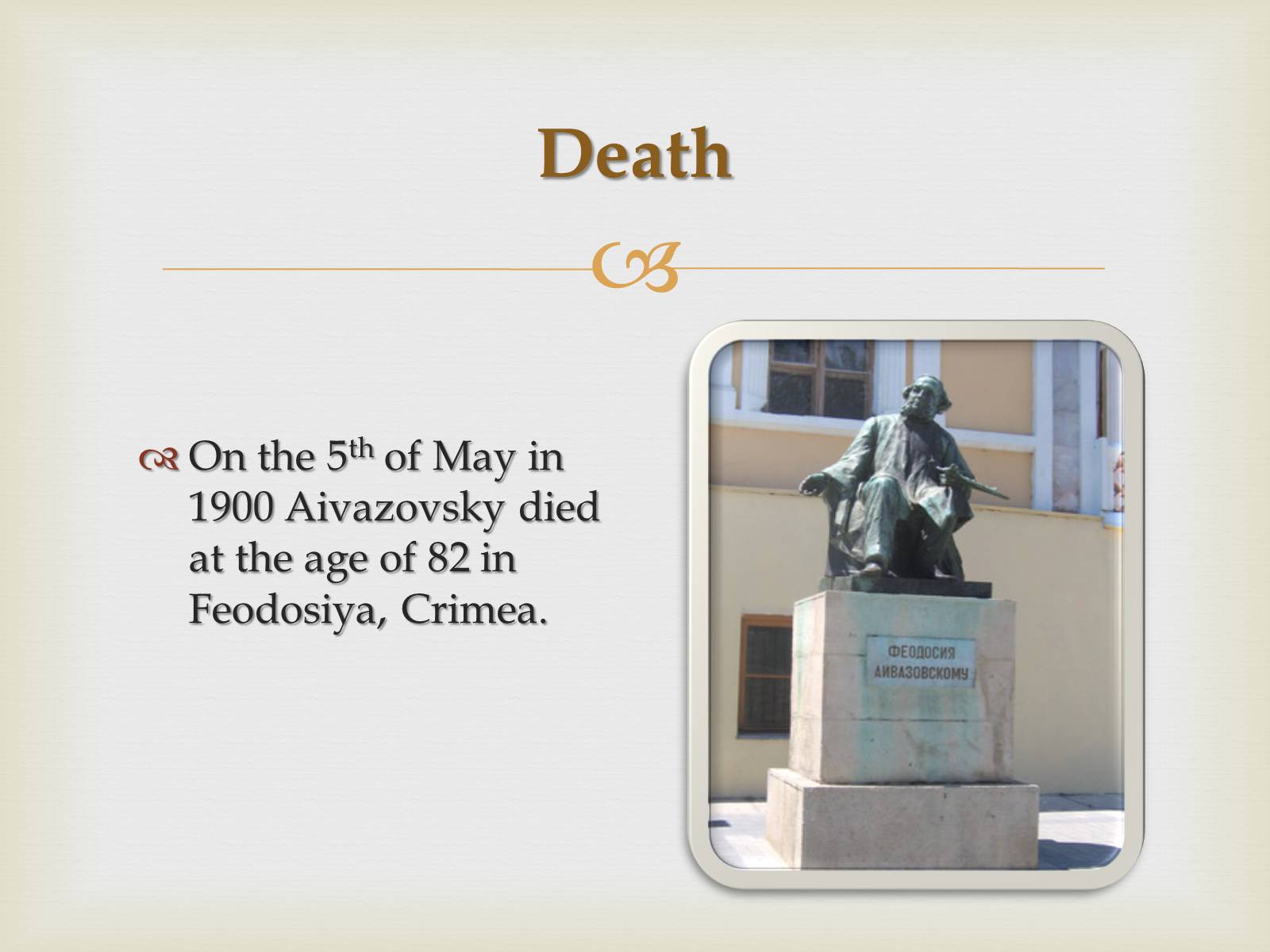- Головна
- Готові шкільні презентації
- Презентація на тему «Ivan Konstantinovich Aivazovsky» (варіант 1)
Презентація на тему «Ivan Konstantinovich Aivazovsky» (варіант 1)
174
Слайд #1
Ivan Konstantinovich Aivazovsky
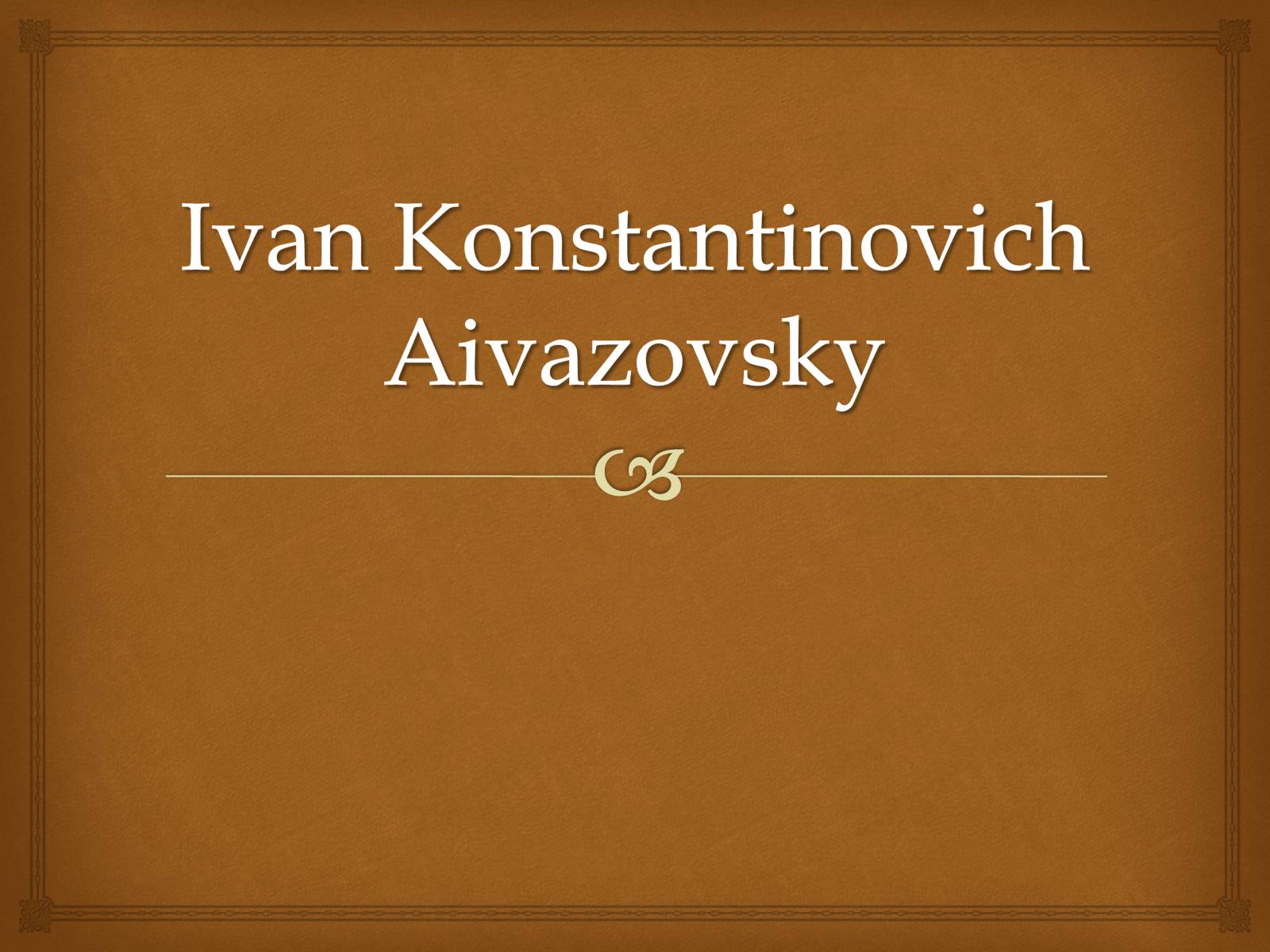
Слайд #2
Aivazovsky was born in the family of a merchant of Armenian origin in the town of Feodosia, Crimea on the 29th of July in 1817. His parents were under strained circumstances and he spent his childhood in poverty.
Aivazovsky was most famous for his seascapes, which constitute more than half of his paintings. Aivazovsky is widely considered as one of the greatest seascape painters of all time.
His main style was Romanticism.
Early biography and some facts
Aivazovsky was most famous for his seascapes, which constitute more than half of his paintings. Aivazovsky is widely considered as one of the greatest seascape painters of all time.
His main style was Romanticism.
Early biography and some facts
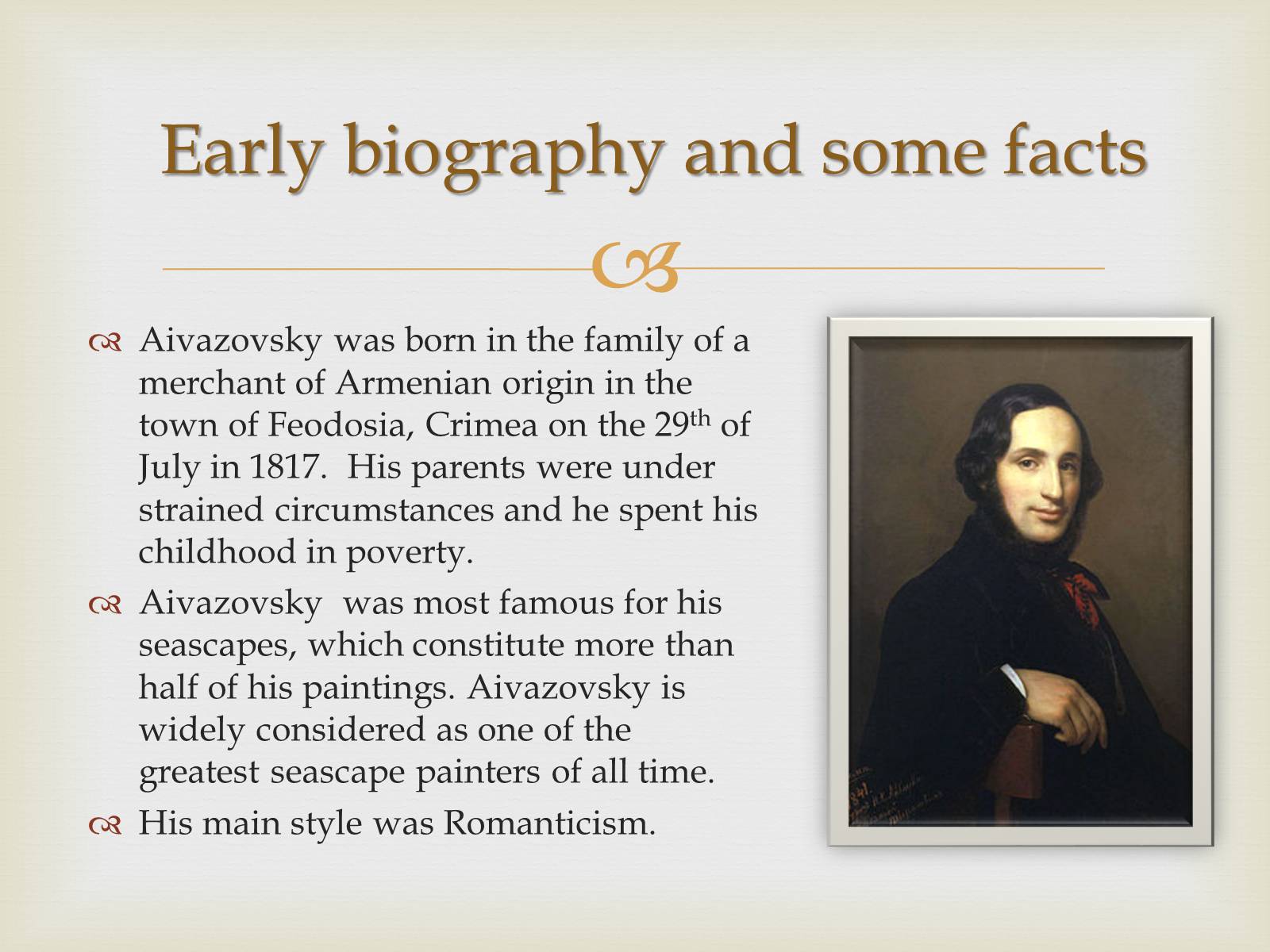
Слайд #3
With the help of people who had noticed the talented youth, he entered the Simpheropol gymnasium, and then the St. Petersburg Academy of Arts, where he took the landscape painting course and was especially interested in marine landscapes. In the autumn of 1836 Aivazovsky presented 5 marine pictures to the Academic exhibition, which were highly appreciated. In 1837, Aivazovsky received the Major Gold Medal for Calm in the Gulf of Finland (1836) and The Great Roads at Kronstadt (1836), which allowed him to go on a long study trip abroad. However the artist first went to the Crimea to perfect himself in his chosen genre by painting the sea and views of Crimean coastal towns.
Beginning
Beginning
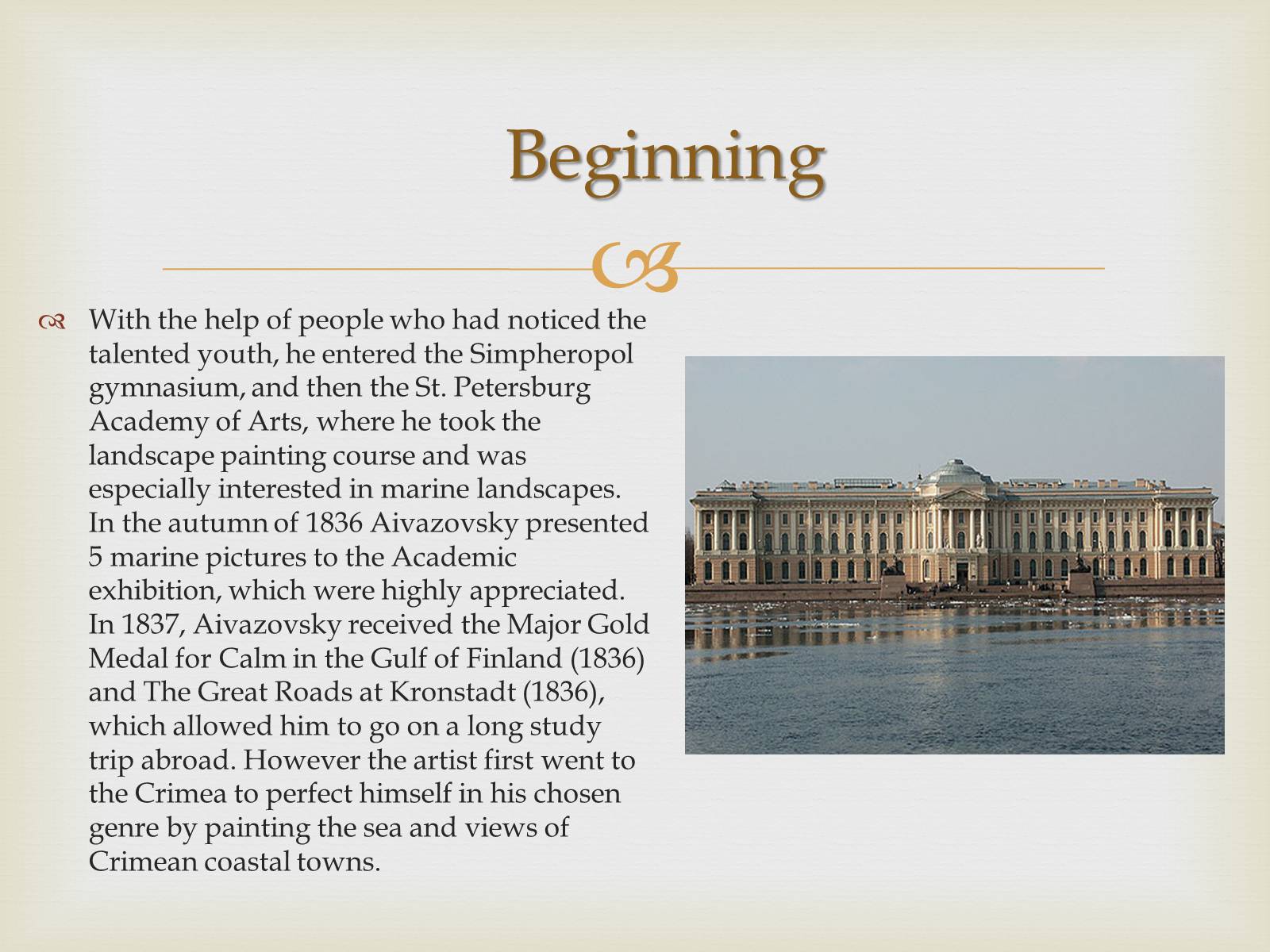
Слайд #4
The first period
During the period of 1840-1844 Aivazovsky, as a pensioner of the Academy of Arts, spent time in Italy, traveled to Germany, France, Spain, and Holland. He worked much and had many exhibitions, meeting everywhere with success. He painted a lot of marine landscapes, which became very popular in Italy: The Bay of Naples by Moonlight (1842), Seashore. Calm (1843), Malta. Valetto Harbour (1844).
During the period of 1840-1844 Aivazovsky, as a pensioner of the Academy of Arts, spent time in Italy, traveled to Germany, France, Spain, and Holland. He worked much and had many exhibitions, meeting everywhere with success. He painted a lot of marine landscapes, which became very popular in Italy: The Bay of Naples by Moonlight (1842), Seashore. Calm (1843), Malta. Valetto Harbour (1844).
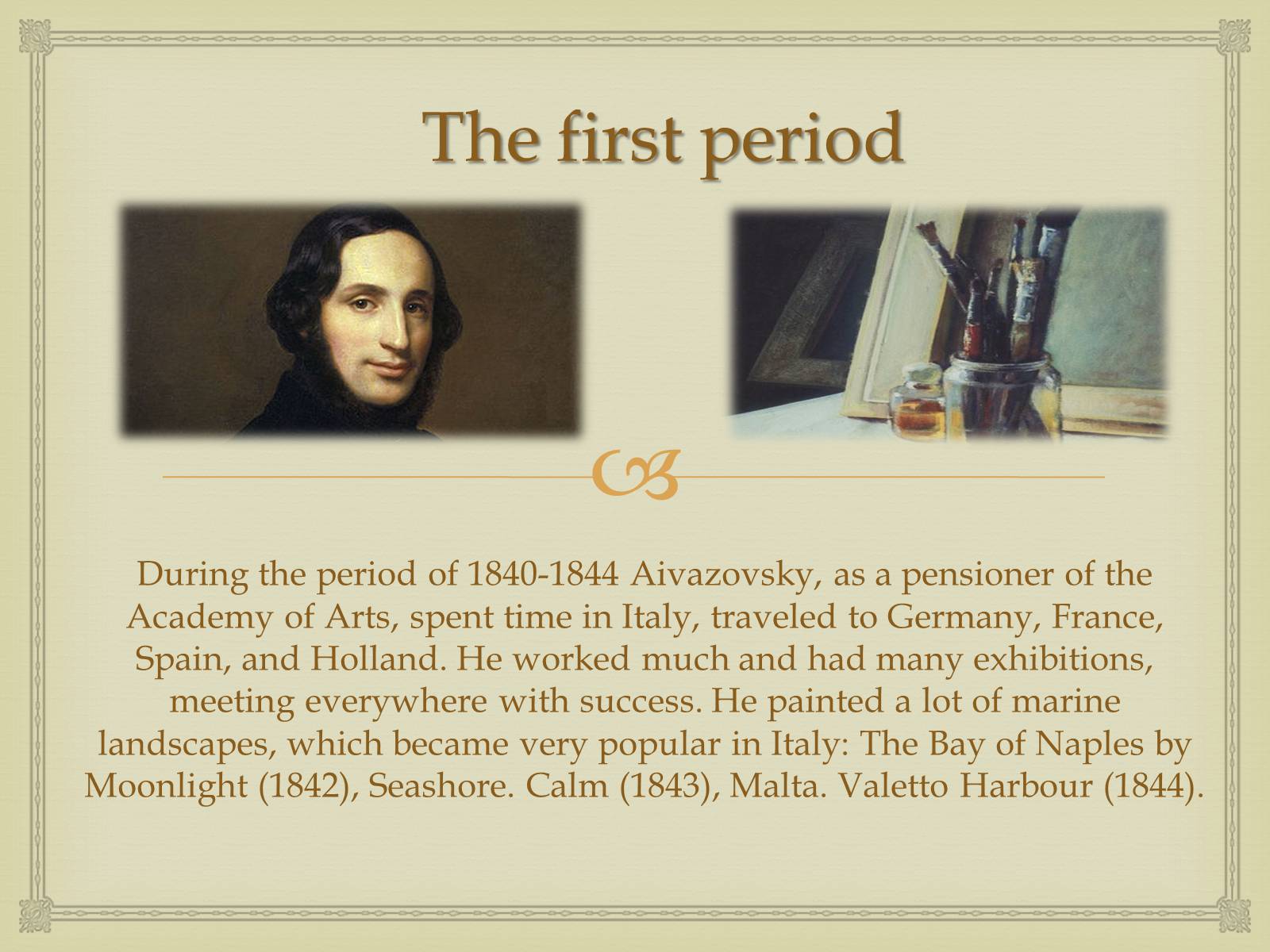
Слайд #5
Seashore Calm (1843)
The Bay of Naples by Moonlight (1842)
The Bay of Naples by Moonlight (1842)
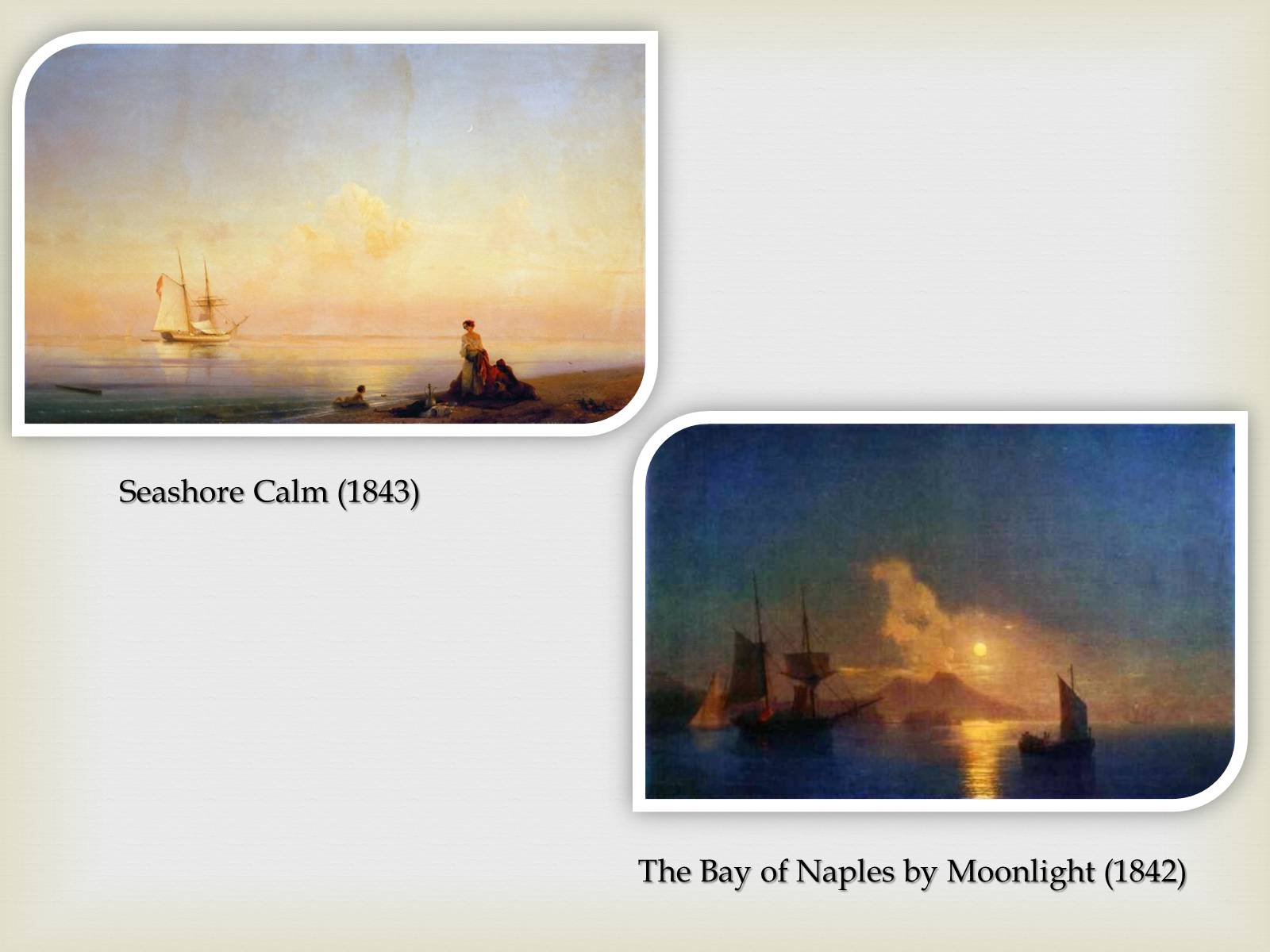
Слайд #6
«Malta. Valetto Harbour»
This is another beautiful seascape picture painted oil on canvas by Aivazovsky in 1844, when Malta was under the British rule and its capital Valetta was a ‘freeport' very much like Aden and Singapore. In the calm seashore there are some people enjoying the sight and a boatload of people is about to enter the water. Large ships laden with goods from England made calls on this seaport everyday. This beautiful painting is held at The Russian Museum at St. Petersburg.
This is another beautiful seascape picture painted oil on canvas by Aivazovsky in 1844, when Malta was under the British rule and its capital Valetta was a ‘freeport' very much like Aden and Singapore. In the calm seashore there are some people enjoying the sight and a boatload of people is about to enter the water. Large ships laden with goods from England made calls on this seaport everyday. This beautiful painting is held at The Russian Museum at St. Petersburg.
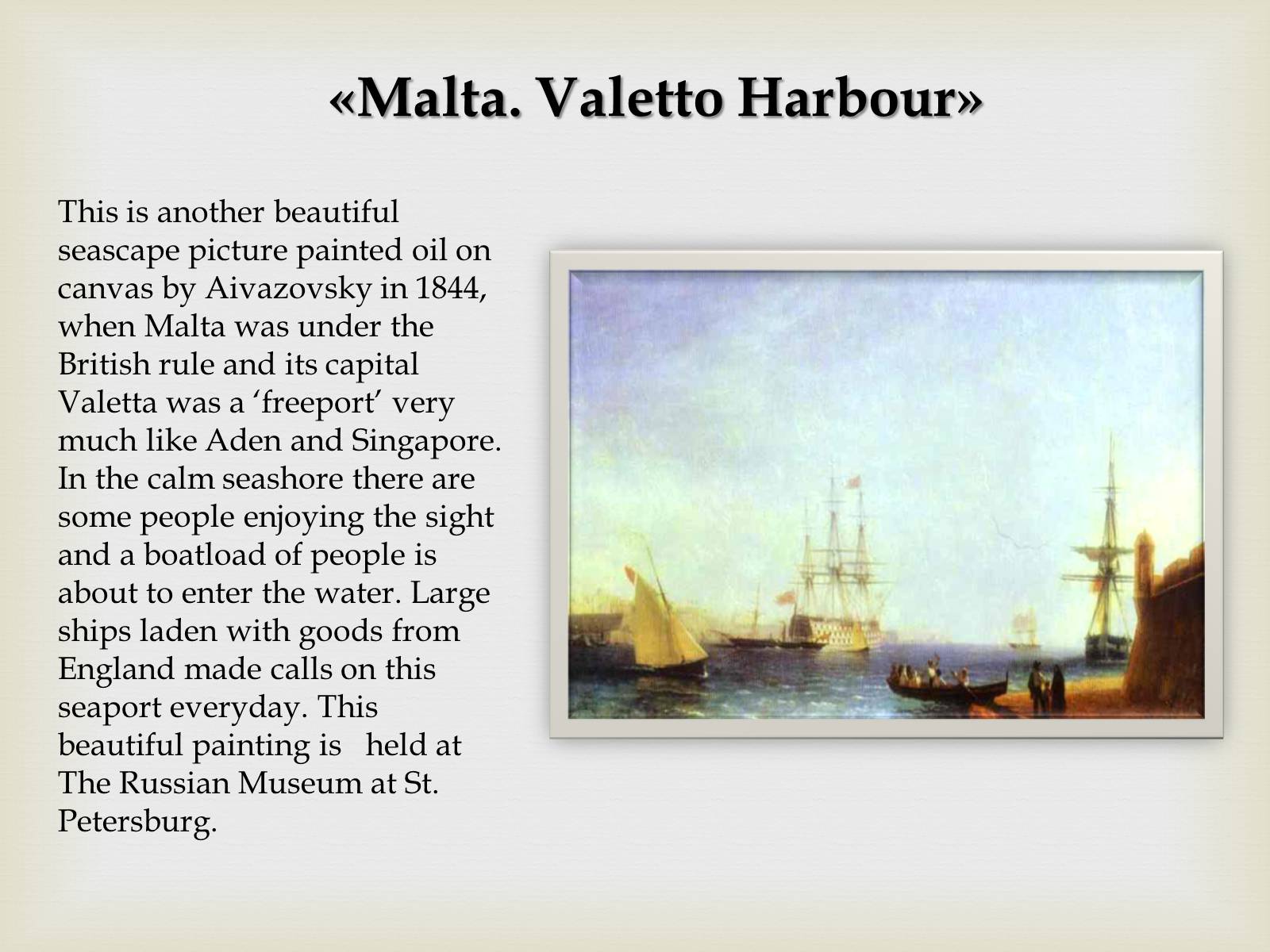
Слайд #7
The second period
When in 1844 the artist returned to St. Petersburg, he was awarded the title of Academician, and became attached to the General Naval Headquarters. This allowed him to travel much with Russian fleet expeditions on different missions; he visited Turkey, Greece, Egypt, America. From 1846 to 1848 he painted several canvases with naval warfare as the subject; the pictures portrayed historical battles of the Russian Fleet The Battle of Chesme (1848), The Battle in the Chios Channel (1848), Meeting of the Brig Mercury with the Russian Squadron... (1848).
When in 1844 the artist returned to St. Petersburg, he was awarded the title of Academician, and became attached to the General Naval Headquarters. This allowed him to travel much with Russian fleet expeditions on different missions; he visited Turkey, Greece, Egypt, America. From 1846 to 1848 he painted several canvases with naval warfare as the subject; the pictures portrayed historical battles of the Russian Fleet The Battle of Chesme (1848), The Battle in the Chios Channel (1848), Meeting of the Brig Mercury with the Russian Squadron... (1848).
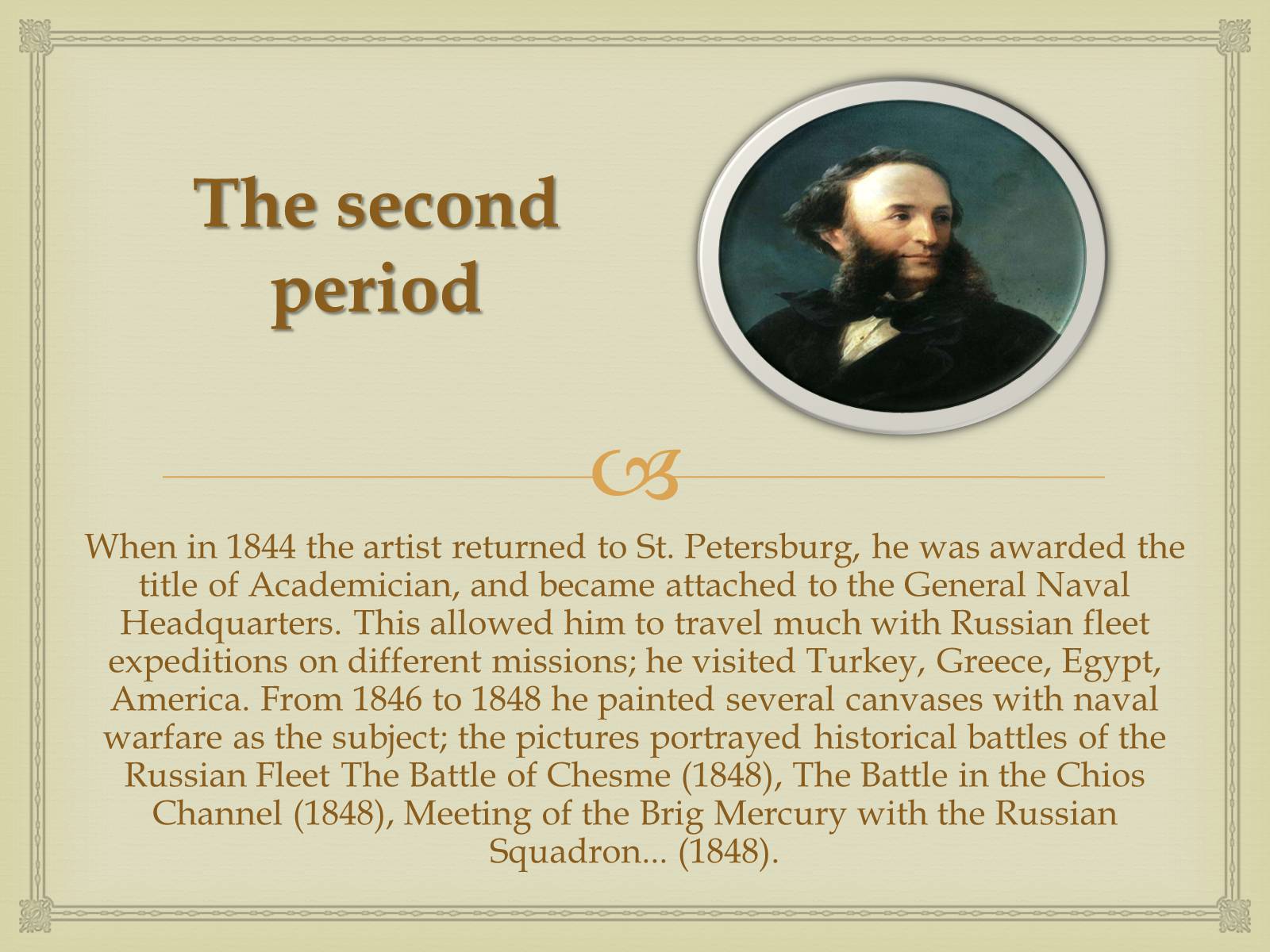
Слайд #8
The Battle of Chesme (1848)
Meeting of the Brig Mercury with the Russian Squadron... (1848)
Meeting of the Brig Mercury with the Russian Squadron... (1848)
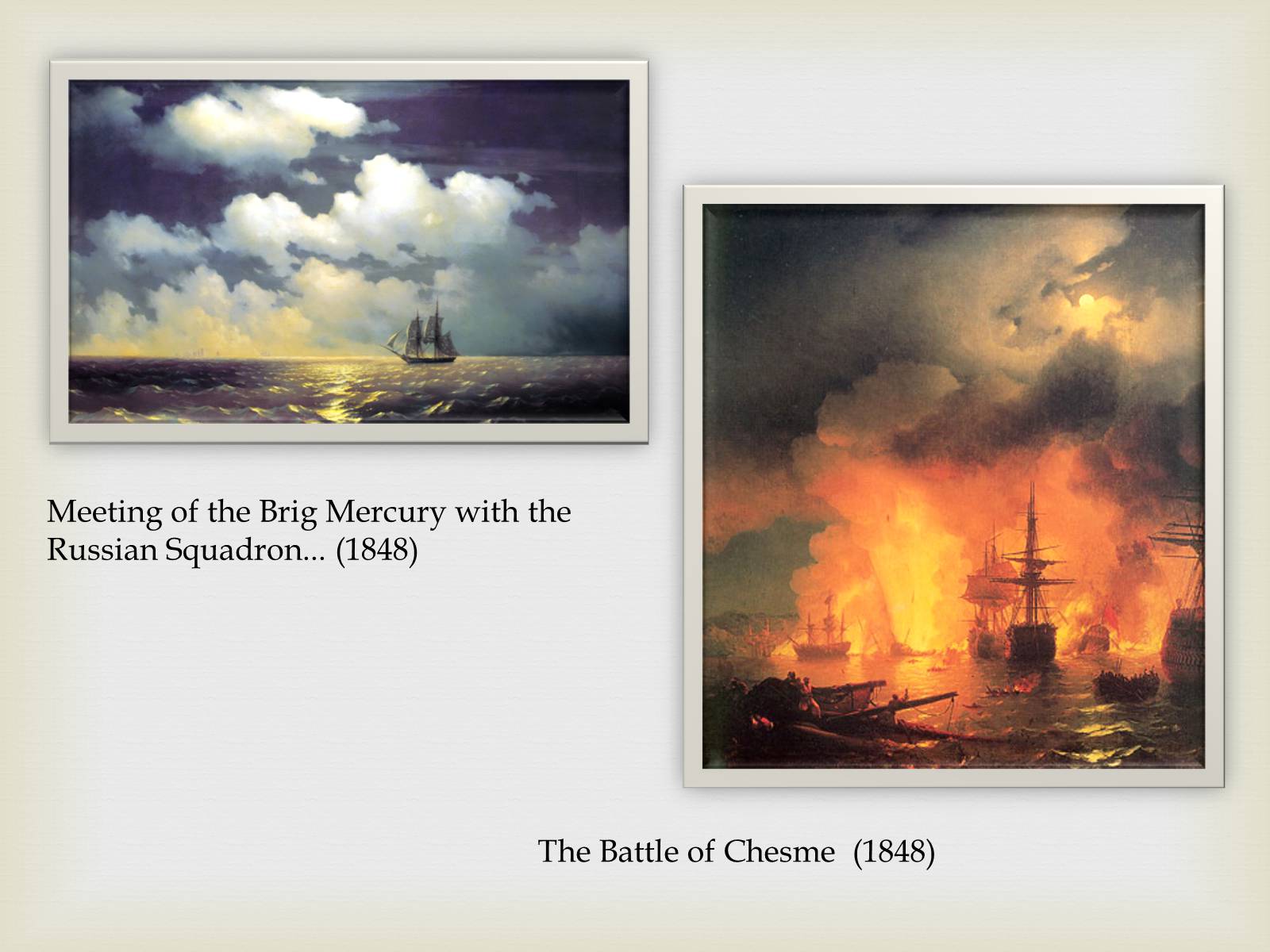
Слайд #9
The clear manifestation of Romanticism
Towards the 1850s the romantic features in Aivazovsky's work became increasingly pronounced. This can be seen quite clearly in one of his best and most famous paintings The Ninth Wave (1850) and also in Moonlit Night (1849), The Sea. Koktebel. (1853), Storm (1854) and others.
Towards the 1850s the romantic features in Aivazovsky's work became increasingly pronounced. This can be seen quite clearly in one of his best and most famous paintings The Ninth Wave (1850) and also in Moonlit Night (1849), The Sea. Koktebel. (1853), Storm (1854) and others.
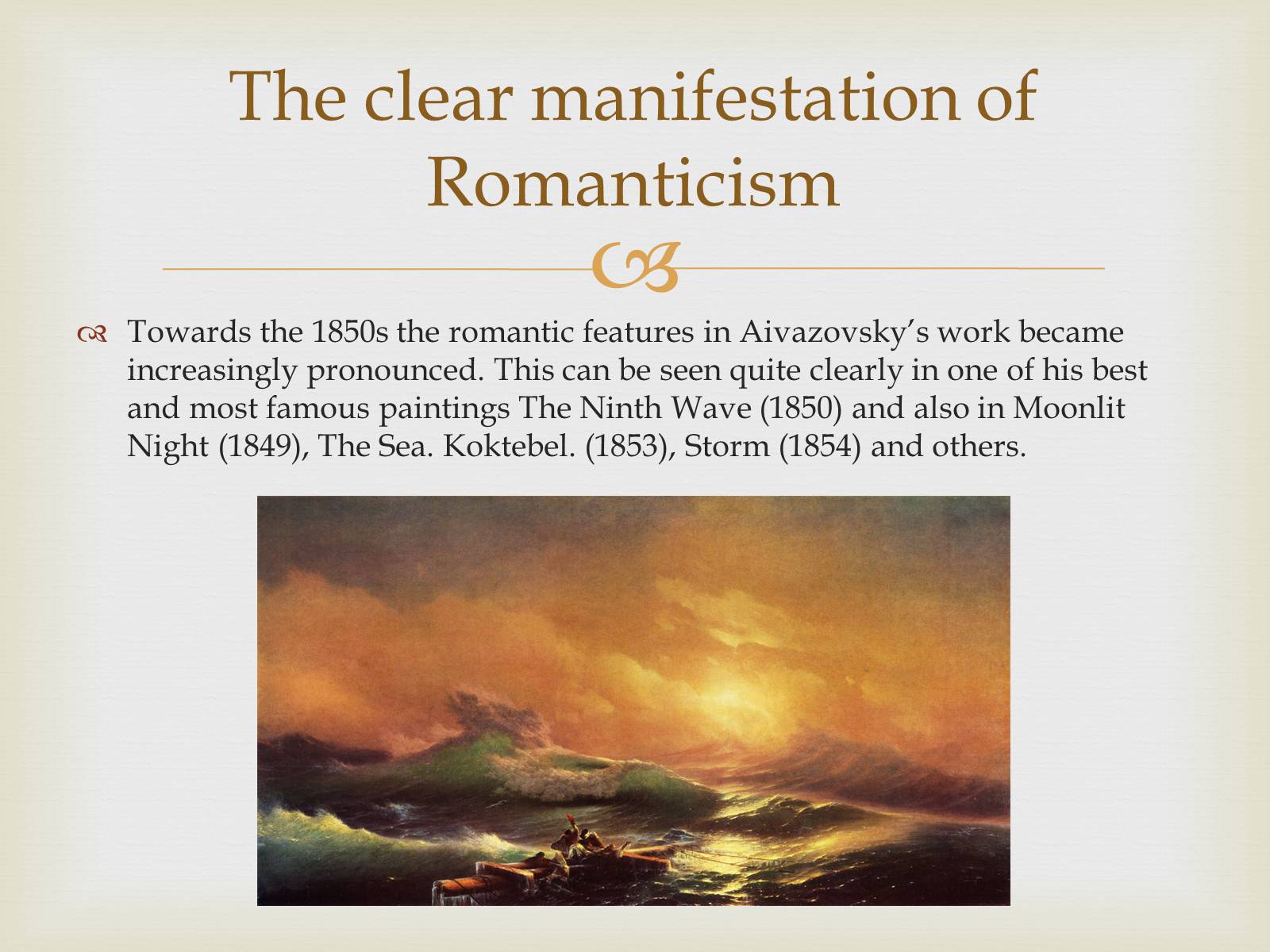
Слайд #10
The Sea. Koktebel
1853. Oil on canvas.
The Aivazovsky Art Gallery, Feodosia, Ukraine.
1853. Oil on canvas.
The Aivazovsky Art Gallery, Feodosia, Ukraine.
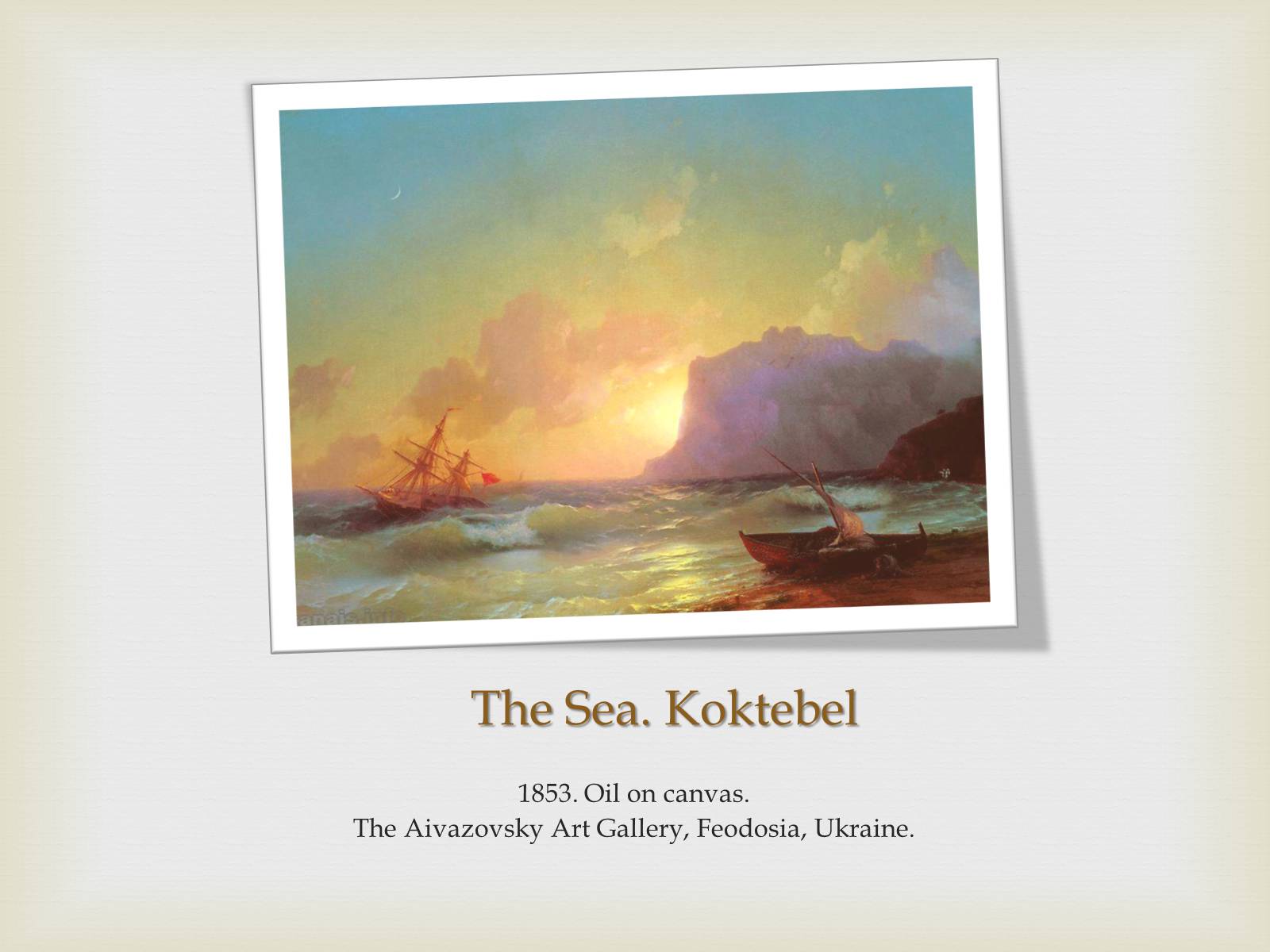
Слайд #11
The process, which determined the development of Russian art in the second half of the 19th century, also affected Aivazovsky. A new and consistently realistic tendency appeared in his work, although the romantic features still remained. The artist's greatest achievement of this period is The Black Sea (1881), a picture showing the nature of the sea, eternally alive, always in motion. Other important pictures of the late years are The Rainbow (1873), Shipwreck (1876), The Billow (1889), The Mary Caught in a Storm (1892).
The mix of realism and romanticism
The mix of realism and romanticism
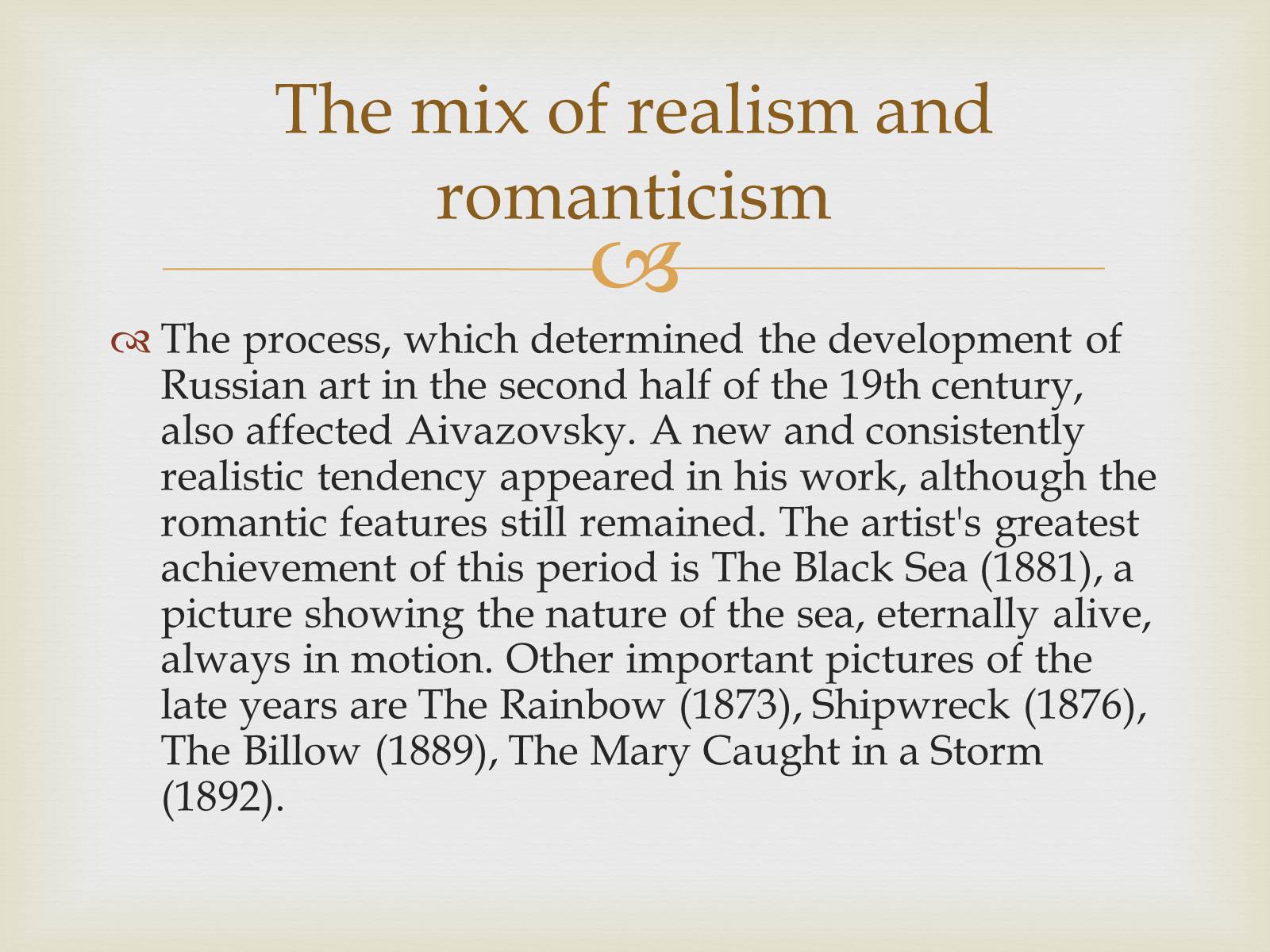
Слайд #12
The Black Sea (1881)
The Mary Caught in a Storm (1892)
The Mary Caught in a Storm (1892)
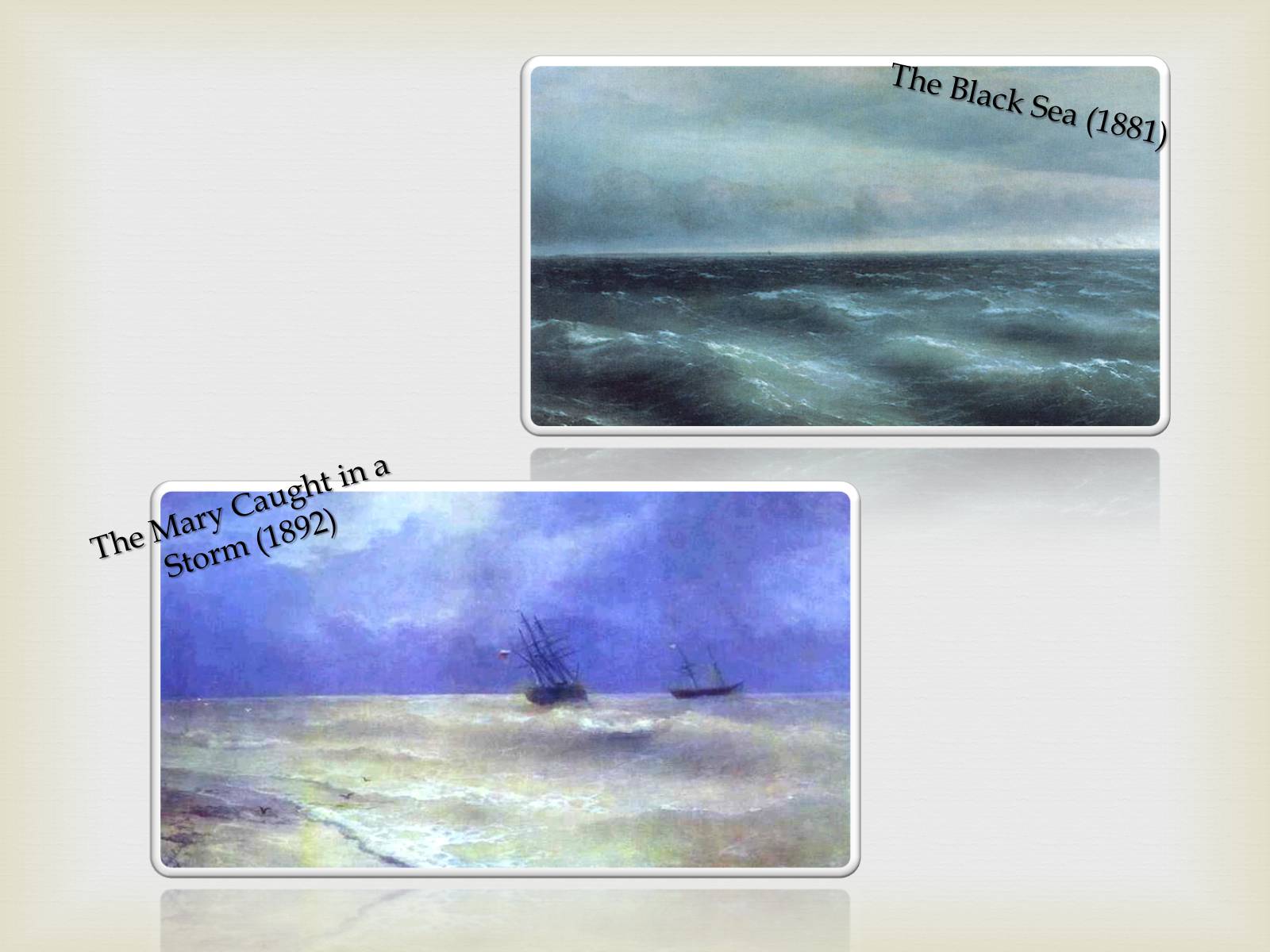
Слайд #13
The last period
Aivazovsky left more than 6000 pictures, which are of very different value. There are masterpieces and there are very timid works. He failed to draw landscapes, could not draw a man. Aivazovsky got good commissions and became rich. He spent much money for charity, especially for his native town, he opened in Feodosia the first School of Arts (in 1865), then the Art Gallery (in 1889). He was a member of Academies of Stuttgart, Florence, Rome and Amsterdam.
Aivazovsky left more than 6000 pictures, which are of very different value. There are masterpieces and there are very timid works. He failed to draw landscapes, could not draw a man. Aivazovsky got good commissions and became rich. He spent much money for charity, especially for his native town, he opened in Feodosia the first School of Arts (in 1865), then the Art Gallery (in 1889). He was a member of Academies of Stuttgart, Florence, Rome and Amsterdam.
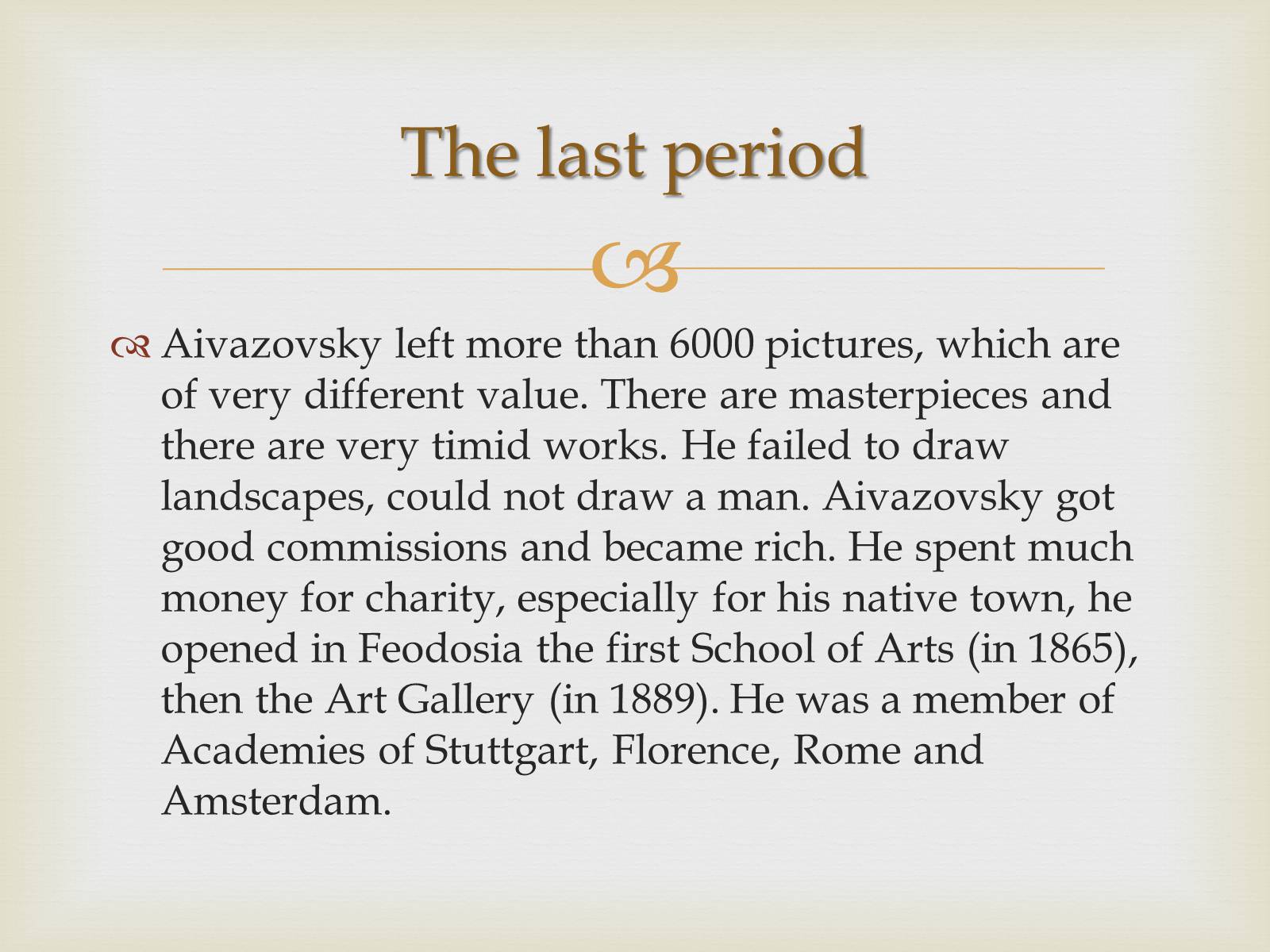
Слайд #14
On the 5th of May in 1900 Aivazovsky died at the age of 82 in Feodosiya, Crimea.
Death
Death
